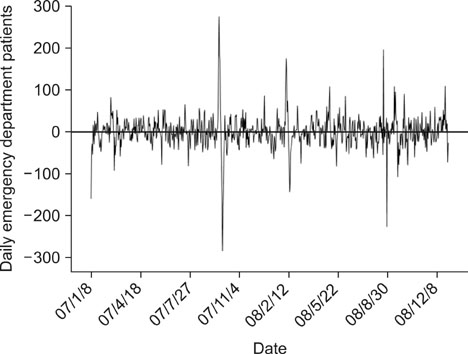Healthc Inform Res.
2010 Sep;16(3):158-165. 10.4258/hir.2010.16.3.158.
Prediction of Daily Patient Numbers for a Regional Emergency Medical Center using Time Series Analysis
- Affiliations
-
- 1Department of Biomedical Informatics, School of Medicine, Ajou University, Suwon, Korea. veritas@ajou.ac.kr
- KMID: 2284528
- DOI: http://doi.org/10.4258/hir.2010.16.3.158
Abstract
OBJECTIVES
To develop and evaluate time series models to predict the daily number of patients visiting the Emergency Department (ED) of a Korean hospital.
METHODS
Data were collected from the hospital information system database. In order to develop a forecasting model, we used, 2 years of data from January 2007 to December 2008 data for the following 3 consecutive months were processed for validation. To establish a Forecasting Model, calendar and weather variables were utilized. Three forecasting models were established: 1) average; 2) univariate seasonal auto-regressive integrated moving average (SARIMA); and 3) multivariate SARIMA. To evaluate goodness-of-fit, residual analysis, Akaike information criterion and Bayesian information criterion were compared. The forecast accuracy for each model was evaluated via mean absolute percentage error (MAPE).
RESULTS
The multivariate SARIMA model was the most appropriate for forecasting the daily number of patients visiting the ED. Because it's MAPE was 7.4%, this was the smallest among the models, and for this reason was selected as the final model.
CONCLUSIONS
This study applied explanatory variables to a multivariate SARIMA model. The multivariate SARIMA model exhibits relativelyhigh reliability and forecasting accuracy. The weather variables play a part in predicting daily ED patient volume.
MeSH Terms
Figure
Reference
-
1. Choung DY, Cho SH, Kim SJ. A report on the environment and the present condition of local emergency medical facilities in gwangju and jeollanam-do. J Korean Soc Emerg Med. 2006. 17:116–123.2. Tandberg D, Qualls C. Time series forecasts of emergency department patient volume, length of stay, and acuity. Ann Emerg Med. 1994. 23:299–306.
Article3. Seo DW, Lim KS, Moon YS, Shon YD, Jo MW, Kim W, Lee IL. Effect of the patients new emergency fee schedule on the pattern of emergency. J Korean Soc Emerg Med. 2004. 15:227–232.4. Je SM, Choi YH, Park YS, Cho YS, Kim SH. How many emergency physicians does korea need? J Korean Soc Emerg Med. 2005. 16:613–619.5. Lee US, Park KS. The users' component satisfaction in the emergency department. J Korean Soc Emerg Med. 1994. 5:336–465.6. Schull MJ, Vermeulen M, Slaughter G, Morrison L, Daly P. Emergency department crowding and thrombolysis delays in acute myocardial infarction. Ann Emerg Med. 2004. 44:577–585.
Article7. Sun BC, Adams J, Orav EJ, Rucker DW, Brennan TA, Burstin HR. Determinants of patient satisfaction and willingness to return with emergency care. Ann Emerg Med. 2000. 35:426–434.
Article8. Choi HS, Lee KW. Analysis of overcrowding in a local emergency department using nAtional emergency department overcrowding scale (NEDOCS). J Korean Soc Emerg Med. 2006. 17:377–384.9. Derlet RW, Richards JR. Overcrowding in the nation's emergency departments: complex causes and disturbing effects. Ann Emerg Med. 2000. 35:63–68.
Article10. Arnold JL, Song HS, Chung JM. The recent development of emergency medicine in South Korea. Ann Emerg Med. 1998. 32:730–735.
Article11. Jung KY, Lim KS, Min YI, Lee SB, Kim SK. The present status of emergency care in emergency centers. J Korean Soc Emerg Med. 1997. 8:441–459.12. Schweiger L, Younger J, Ionides E, Desmond J. Autoregression models can reliably forecast emergency department occupancy levels 12 hours in advance. Acad Emerg Med. 2007. 14:S82.13. Jones SS, Evans RS, Allen TL, Thomas A, Haug PJ, Welch SJ, Snow GL. A multivariate time series approach to modeling and forecasting demand in the emergency department. J Biomed Inform. 2009. 42:123–139.
Article14. Hwang SW, Lee HJ. Development of a revisit prediction model for the outpatient in a hospital. J Korean Soc Med Inform. 2008. 14:137–145.
Article15. Schweigler LM, Desmond JS, McCarthy ML, Bukowski KJ, Ionides EL, Younger JG. Forecasting models of emergency department crowding. Acad Emerg Med. 2009. 16:301–308.
Article16. Asplin BR, Flottemesch TJ, Gordon BR. Developing models for patient flow and daily surge capacity research. Acad Emerg Med. 2006. 13:1109–1113.17. Jones SS, Thomas A, Evans RS, Welch SJ, Haug PJ, Snow GL. Forecasting daily patient volumes in the emergency department. Acad Emerg Med. 2008. 15:159–170.
Article18. Sun Y, Heng BH, Seow YT, Seow E. Forecasting daily attendances at an emergency department to aid resource planning. BMC Emerg Med. 2009. 9:1.
Article19. Lee JY, Min JH, Park JS, Chung SP, Park JS, Jung SK, Yang YM. The association of meterological and day-of-the week factors with patient visits to emergency centers. J Korean Soc Emerg Med. 2005. 16:287–291.20. Korea Meteorological Administration. c2009. cited at 2009 April 20. Available from: http://www.kma.go.kr/.21. Do JD. A study the change point of stock price. J Inst Nat Sci. 2007. 25:27–34.22. Yi KH, Chung HK, Park JS. The prediction model of the number of industrial injured persons using data mining. Korean J Occup Environ Med. 2000. 12:515–523.
Article23. Akaike H. A new look at the statistical model identification. IEEE Trans Automatic Control. 1974. 19:716–723.
Article24. Schwarz G. Estimating the dimension of a model. Ann Statist. 1978. 6:461–464.
Article25. Batal H, Tench J, McMillan S, Adams J, Mehler PS. Predicting patient visits to an urgent care clinic using calendar variables. Acad Emerg Med. 2001. 8:48–53.
Article
- Full Text Links
- Actions
-
Cited
- CITED
-
- Close
- Share
- Similar articles
-
- Regionalization of emergency medical system and re-establishment of regional emergency medical plan
- The Effect of Socio-Economic Factors on Occupational Injuries in Korea: A Time Series Analysis
- Development and Validation of a Prediction Model for the Number of Patients Visiting Emergency Departments
- Regional Cardiocerebrovascular Center Project in the Treatment of Acute Myocardial Infarction
- A Comparison of the Effectiveness of Before and After the Regional Trauma Center's Establishment




